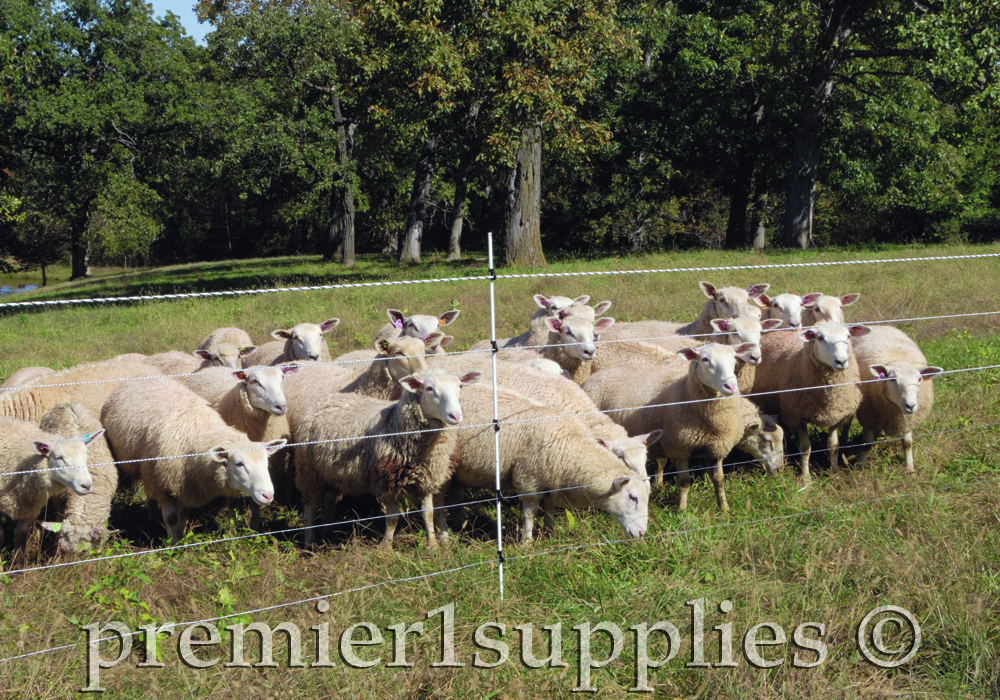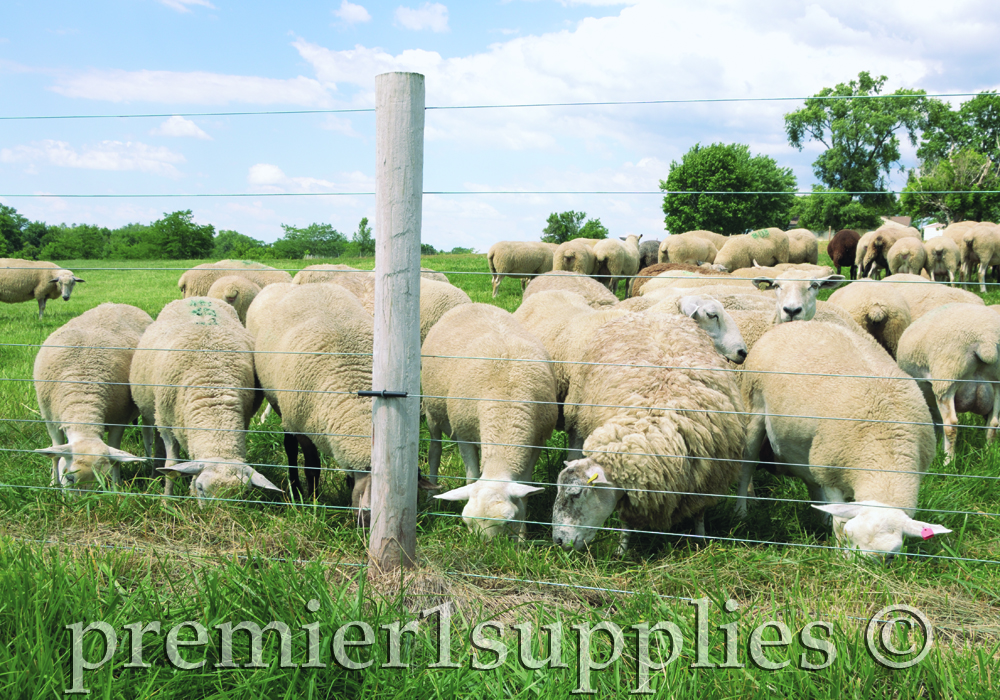Fence, whether it is temporary or permanent, takes time and money to build. So make sure when you pick your materials, you do it right the first time. Having the right fence when and where you need it helps ease the mind when you’re not in the field. Following the tips below will help in coming to the right decision.
1. Will the fence be moved? If so, how often?
A. Daily or weekly (Temporary/very portable)
Design must be quick to install or remove. To eliminate the need for large end and corner posts, the fence strands, whether single, multiple or a mesh, must be electrified and under minimal tension.
Boundary sites?
Electrified netting is the best temporary boundary fence. Why? Because it stops sheep, goats, dogs and most coyotes.
Specific suggestions:
• Use 35″ ElectroNet® or E’Net™ only if animals are trained to netting and are neither tall nor flighty. It’s less $$ and easier to use than other netting.
• Use the taller ElectroStop®, E’Stop™ or ElectroFence™ for flighty animals.
Internal sites?
• Netting is the quickest to install and/or remove. It’s also more reliable but more expensive per ft to purchase.
• Or use 2 strands of IntelliTape™ or 3 strands of IntelliTwine on reels. Much cheaper per ft than netting but more labor to install.
It will stop most adult ewes and feeder lambs. But it will not stop coyotes, dogs, young lambs/kids, goats, hungry sheep or rams/billies during the breeding season.

A multi-strand fence with rope, twine and MaxiShock. Rope and twine provide visibility to both animals and humans. The bottom wire is MaxiShock.
B. Once per season (Semi-permanent)
Can be an interim barrier until a more permanent fence is installed. This allows folks to field-test fence and gate locations to see what works best. Usually consists of electrified net or multiple electrified strands under low tension—supported by stronger posts than temporary fences. Will need more attention than permanent fences.
• PermaNet®. Faster to install and remove than 4 to 5 strand fences. More expensive but more reliable. PermaNet must be electrified.
• Or use 5-strand multi-strand fences. Much less expensive but also less reliable than PermaNet.
C. Never (Permanent)
For boundary and subdivision fences for land that’s owned by the user—and whose usage is not likely to change! Requires strong wood, steel or fiberglass posts which support high-tensile wires, woven wire, rope or wide tape—of which one or more strands are electrified. More reliable than other options but more expensive to install. May require a professional installer.
In our experience the following design has been reliable and cost effective:
a. One GreenCote barbed wire 1″–2″ above the soil to deter guard dogs and coyotes from digging out/in.
b. Above that GreenCote® HT woven wire 8/32/9 or similar. For 8/32/9 add 2 non-energized HT wires to produce a fence that’s 45″–48″ tall.
c. Wood or steel line posts no more than 25 ft apart. All corner/end posts must be wood and well-braced.
d. One or 2 “live” wires or ropes offset on the grazed side. We find that offset strands at 7” and 30″ will stop lambs, kids, adult sheep/goats and most of their predators.
This combination forms a reliable, maintenance-free, aesthetic barrier that keeps nearly all guard dogs and livestock in and coyotes out.
Subdivision sites?
• Same design as for boundary fences.
• Or use only 7 or 8 smooth HT wires of which 2 are off-set and energized. Much less $$ but also less reliable.
Barbed wire fences?
A producer from Utah reported success in dry sites with fences made of 6 to 8 strands of GreenCote barbed wire (it has very nasty barbs) attached to wood or steel posts. We tested this design at Premier. It’s expensive but it absolutely stops dogs, coyotes, cattle, sheep, goats and most hunters. Don’t let horses near it!
Floodplain sites?
We use a 5-strand fence composed of:
a. IntelliRope™ 4.5 below the normal high water level.
b. HT smooth wire above that.
c. Wood line posts. (Wood posts resist the side pressure created by floods better than steel or fiberglass.)
The flood will break the IntelliRope and leave the posts and upper HT wires in place. It’s easy to refit the IntelliRope.
Water gaps…
• Old or damaged electrified netting supported by extra FiberRods. Each flood will further degrade it.
• Or install up to 4 strands of “live” tape/twine on 1/2″ fiberglass rods. This is much cheaper than net, less likely to tangle and easily repaired—but less reliable against creative animals.
Field gates…
• Temporary gates? Use NetGate™ 3.0. Repels coyotes and dogs as well as livestock. Can be adapted to any length. Low-cost. Easy to install.
• For more permanent gates Premier’s 4 ft tall welded wire panels (though some guard dogs crawl over them).
• For electrified netting fences just remove an end post and pull the net back to let animals/machines in/out.
2. What’s the fence’s location?
Is it flat? Or does it go over hills and ditches and around curves? Is it covered with brush, trees or open grass? Are the soils rocky, very soft, sandy or firm? The optimum fence design often hinges on answers to these questions.
3. Do the animals know the fence?
Local animals and wildlife get to “know” a fence by appearance, site and “pain memory.” If it’s a strong or painful fence they avoid it.
On the other hand new animals just off a truck often charge into permanent fences and straight through temporary or semi-permanent fences. That’s why strong, tall, visible permanent fences are essential for receiving corrals and feedlots.
Temporary fences that are not physically strong pose the greatest risk of escape to newly acquired animals. It pays to train them to it inside of a permanent fence.
4. What specific animals need to be fenced in or out?
Always design and build for the most difficult species. Some rules of thumb:
- Most sheep and goat fences will stop cattle. The inverse is not always true.
- Fencing adult males (bulls, rams, stallions, billies) in/out requires taller fences with closer wire/strand spacing and more powerful electric pulses.
- Fences for mixed sizes (ewes with lambs, cows with calves, etc.) need more strands than uniform animal groups.
- Certain breeds need better fences (e.g. flighty Romanov sheep, tall Columbia sheep, Chianina cattle).
5. Should you energize the fence?
It usually pays to do this. Why?
- A “hot” strand has a “zone of pain” around it. So fewer strands are needed if one is energized. Both the material and the labor to install is reduced.
- Energized fences last longer and require less maintenance—because animals do not crowd, rub or scratch on them. So the fence wires (including wires that are not energized) require less tension to do their job. And braces and corner posts will last longer.
- Animals are more surely contained and excluded during breeding and weaning.
6. How keen will animals be to breach the fence line?
Build for the worst-case situation if you can afford to do so. Some situations that require more secure fences:
- Hunger. Starved animals will eventually challenge most fences.
- Weaning. Strong physical barriers are needed to cope with separation.
- Breeding. Libido induces all creatures to challenge rules (and fences).
- Boredom. Animals in corrals, stalls and lots crave any “entertainment.”
- Gateways and handling yards. Animals often push each other into fences when being moved about.
- Goats. Without doubt they are clever and creative escape artists.
- Fear and fright. Predators or loud noises can cause “prey” species (e.g. horses, goats, turkeys) to run in terror straight into, under, over or through any fence, no matter what fence design (netting, hi-tensile or woven wire).
7. How visible should a fence be?
It depends. Horses, deer and antelope move at high speed and have restricted color perception (compared to humans). They may not see small fence wires like HT wire, MaxiShock or some polywires. So they may charge right through them.
That’s why it’s wise to include one or more strands of bi-colored rope or tape (both highly visible) in fences.
8. Are long, dry periods common?
Electric fences typically rely upon soil moisture as a conductor. When the soil is dry or covered in dry snow, normal electric fences and low-impedance energizers may not work.
Solutions for this are:
- Use a wide-impedance energizer. They’re less affected by dry soil.
- Integrate earth-return wires (connected to energizer’s negative terminal) into the fence. Animals must touch 2 strands but it works well.
9. What’s the cost if the fence fails?
The higher the potential cost (in time and money) of a failure, the more reliable the fence design should be. Examples:
- Along public highways. In some states the land owner is liable for damages to both vehicles and humans. So owners in these areas must build better fences to reduce risk.
- Around stored feed. If animals gorge on grain, death may occur.
- Protect high-value e.g. crops, gardens, orchards or young tree plantings from deer. Protect poultry/sheep/goats from dogs, coyotes, etc.
- Fences with animals on both sides. Mix-ups are time-consuming. They’re very costly if the animals breed or spread disease. Neighborhood relations can be strained. Lawsuits may occur.
10. Is it a lane or a corral fence?
These situations often force animals into contact with fences. Such fences need better visibility, high strength and if possible, no “hot” wires.
11. Will heavy snow or ice occur?
Enough ice can bring down the strongest power lines so all fences are vulnerable. But some cope better than others. Are your animals likely to penetrate the fence before the ice melts?




